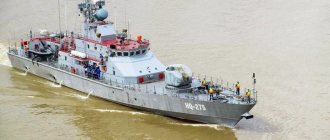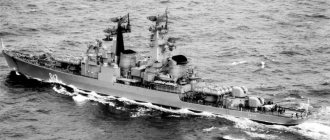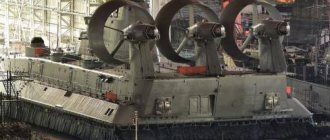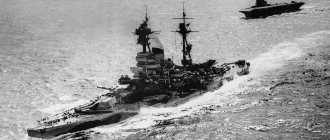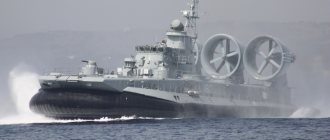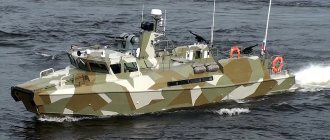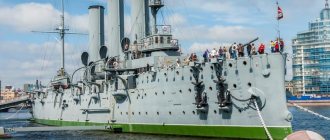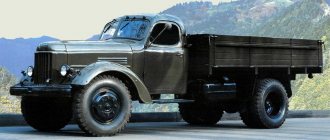The Soviet Union is rightfully considered the ancestor country of such a class of warships as missile boats. The naval concept for the development of the fleet, developed in the depths of the Supreme Naval Leadership, provided for equipping the fleet with small combat vessels, which in terms of weapon power were comparable to ships in the far sea zone. The creation of a “mosquito fleet” made it possible to create effective means of defense of sea borders in a short time and at fairly low costs. High speed, stealth and powerful missile weapons made such ships truly dangerous opponents for any warship.
The appearance of missile boats at sea negated the advantages of a large ocean-going fleet in the coastal sea zone. Subsequent historical events showed the correctness of the developed concept. The missile boats created by Soviet designers became a “revolutionary breakthrough” in the history of world military shipbuilding. Despite their small displacement, thanks to their high speed and powerful weapons, ships of this class were classified as corvettes in the Western classification. Missile boats of the Project 1241 type, which were built at domestic shipyards over the course of 17 years, are rightfully considered one of the best representatives of ships of this class.
Project 1241 Molniya missile boats
The main trump card of the Molniya-class boats is, of course, their strike weapons.
When the Soviet Union created the world's first supersonic anti-ship missile (ASM), the Moskit, which was virtually undetectable by air defense and missile defense systems, they decided to equip it not only with large ships, but also with boats. “Mosquitoes” in the “mosquito” fleet are not a tautology, but a transition of the RKA’s combat potential to a fundamentally new level. PROJECT
Work on the creation of a new generation missile boat began at the Leningrad Central Design Bureau "Almaz" in 1973. The project received the number 1241 and the code “Molniya”; E.I. Yukhnina was appointed its chief designer. According to the plan, the project was to become the basis for a whole family of boats - missile, anti-submarine and patrol boats.
Already at the first stage of development, it became clear that fulfilling all the requirements of the technical specifications (powerful missile and artillery weapons, new energy, high speed) would lead to a significant increase in displacement. As a result, Molniya-class missile boats, despite their undeniable advantages, lost the advantages of the representatives of the “mosquito” fleet of the previous generation - their small size, low cost and, as a consequence, the possibility of mass construction.
The Molniya type RCAs were built in several series. Since the creation of the Moskit anti-ship missile system and a combined diesel-gas turbine power plant was delayed, the first 15 boats represented a compromise option - Project 1241T: they were equipped only with gas turbines and were armed with reliable, but already obsolete P-15M Termit missiles. Since 1981, RKA with Mosquitoes began to enter service; their project received the designation 12411. The export version of the Molniya (project 1241RE) generally repeated the 1241T project, differing only in the composition of the radio-electronic equipment. One of the Black Sea Fleet boats was used as a test boat to test various anti-aircraft weapons; his project was assigned the number 12417. Finally, already in the 2000s, an export version of the Molniya with the Uran anti-ship missile system was developed - project 12418. Boats of this modification are available in the navies of India, Vietnam and Turkmenistan.
DESCRIPTION
The boat's hull is steel, smooth-deck, and inside it is divided into ten compartments by waterproof bulkheads. The superstructure is made of aluminum-magnesium alloy. The main power plant is a combined one, consisting of two full-speed gas turbines with a capacity of 12 thousand liters each. With. and main engines - also gas turbine (on project 1241T) or diesel (project 12411). The transition to diesel engines made it possible to reduce the fuel supply from 76 to 56 tons without loss of cruising range. RKA projects 1241T and 1241RE each carried two twin transport and launch containers with P-15M Termit missiles. The most popular Molniyas of Project 12411 were armed with supersonic anti-ship missiles ZM-80 Moskit with a firing range of 120 km. Export boats of Project 12418 are equipped with compact subsonic anti-ship missiles X-35 Uran. By reducing their weight and size characteristics, the number of missiles on the boat increased fourfold, to 16 pieces.
Artillery armament included one 76-mm AK-176M automatic gun mount and two 30-mm AK-630M automatic guns. In addition, there was a stationary installation for two blocks of Strela-ZM or Igla MANPADS. On the experimental boat R-71 of Project 12417, anti-aircraft artillery and missile-artillery systems “Kortik” and “Broadsword” were tested.
Target detection and target designation on boats of projects 1241T and 1241RE were carried out by the radar complex (RLK) "Garpun", on boats of project 12411 - radar complex "Monolit-T".
EXPLOITATION
RKA of the Molniya family were built at factories in Leningrad, Rybinsk and Khabarovsk. The lead boat R-5 (project 1241T) entered service in 1979, the lead boat R-46 (lead project 12411) - in 1981. In total, 49 boats were built for the USSR and Russian Navy until 2003: 14 project 1241T, 34 project 12411 and 1 project 12417. They were part of the Baltic, Black Sea, Pacific fleets and the Caspian flotilla. About 30 of them are still in service today. Another 25 boats were built in 1983-2011 for export: 21 projects 1241RE and 4 projects 12418. They were supplied to the GDR, Poland, Romania, India, Vietnam, Yemen and Turkmenistan. In addition, two Project 1241T boats from the Black Sea Fleet were transferred to Ukraine and one to Bulgaria. In most countries they were classified as corvettes.
In 1991-2002, the Molniya missiles (eight units) were built under license in India, the last two being built according to an improved project 12418 with the AK-176M gun mount replaced by the Italian 76-mm OTO-Melara. One of the Indian corvettes, the K98 Prahar, sank in April 2006 as a result of a collision with a merchant ship.
Currently, Project 12418 boats are being built under license in Vietnam. The first two RKA were delivered to the fleet in July 2014. A total of eight boats are planned to be built in this country.
Variety of models
All boats with the Raketa brand have a number of common features. First of all, they all have a low-pressure inflatable bottom (with LPND). The variety of the model range is achieved by varying the size, thickness of the PVC material and cockpit finish of the products. In common parlance, all the company’s boats are usually called rubber, since their design has absolutely no rigid elements, with the exception of a reliable transom for the motor and can seats on some models.
Thus, even the lightest versions of the “Rockets” can be classified as motor boats based on the combination of the main characteristics of PVC boats. The special conical design (the profile widens towards the stern), developed for all “Rockets”, makes them very stable on course even with a low-power motor. The effect is enhanced by the position of the bottom above the lower level of the cylinders, which creates a flow at speeds of more than 20 kilometers per hour, which helps to go into planing. The optimal length of the hull cones and the position of the transom, obtained experimentally, also help keep the Rocket on course.
All products are manufactured in three main configuration options, representing the “Egoist”, “L” and “S” series.
Series "Egoist"
As can be concluded from the name of the series, the boats are intended for individual use. They are lightweight, passable in shallow water, and easy to control. Vessels of this series are very popular among amateur fishermen and hunters.
Prominent representatives of the series are “Rocket RL 300” and “Rocket RL 320”. The digital index indicates the length of the product in centimeters. Thus, boats of the “Egoist” series, intended for individual use, turn out to be slightly larger than similar individual watercraft from other companies, having a length of about 2 m. However, the weight of the product, due to the absence of rigid floors, does not exceed 20 kg, which makes it quite easy to transport the boat to a reservoir or from one body of water to another for an adult man, without resorting to outside help.
The boat kit includes a convenient pump that can control the degree of inflation of the cylinders. When the optimal pressure is reached, it becomes difficult to pump with its help - this signals that the balloon is fully inflated.
Under a light outboard motor, up to 6 horsepower, these boats feel great, they have good handling, and the inflatable flat bottom completely absorbs impacts on the water.
There are oars, the length of which can be adjusted according to the height of the rower.
Series "L"
The boats of the series have a length from 330 to 380 cm. The load capacity exceeds 550 kg, which allows them to accommodate 3-4 people. The cylinders and bottom of the boats are reinforced with a special additional layer of PVC. The weight of the boats is close to 30 kg.
“Raketa RL 330” and “Raketa RL 350” have a reinforced bottom, which allows you to safely overcome overgrown shallow water or rocky areas. The motor for which the transom and hull of the boats are designed can have a power of up to 15 horsepower.
The RL 380 rocket, despite its impressive size, is lightweight. High-quality PVC has increased density. A motor with a power of up to 20 hp can be installed on the transom. sec., the speed on calm water reaches 40 km per hour even with maximum load (4 people and corresponding luggage).
Series "C"
Structurally, the products in the series are distinguished by an inflatable keel bottom. The length is 350 cm (“Rocket RS 350”) and 380 cm (“Rocket RS 380”). The boats are designed to carry 3-4 people. The reinforced bottom allows them to be used not only in open water, but also in shallow water. Even with a 10 hp engine. With. representatives of the series develop decent speed and are highly seaworthy, easily going into planing.
The conical design of the cylinders is complemented by support steps - original guides for the flow of water that occurs in planing mode, which significantly improves the gliding of the craft.
Lightning-fast sea "Tarantula" - missile boat of project 12411 "Molniya"
Since 1981, Molniya missile boats in modification 12411 (12411M) began to enter service with the Navy of the Soviet Union. They are a development of the Molniya RK project 1241. The main developer is the Almaz association. In total, more than three dozen missile boats were built at various shipyards. The main difference is the installation of an anti-ship missile system with 3M-80 Moskit missiles, instead of Termit (P-15) missiles.
Nowadays, missile boats of the 12411 series are in service with the Russian Navy. Quite recently, Libya ordered three missiles with Mosquito anti-ship missiles for the needs of its Navy. (Since 2008, the Libyan side has ordered project 12411 from the shipbuilding 3 RK. The estimated cost of the order is about $200 million).
History of the development of the RK project 12411
Combat operations involving missile ships armed with P-15 anti-ship missiles in 1967 (Arab-Israeli conflict) and 1971 (Indo-Pakistan conflict) became the starting point for the creation of a missile boat carrying on board an improved anti-missile system with a more powerful and modern anti-ship missile "Moskit". Initially, assessments were made of the possibilities of deploying Mosquito anti-ship missiles on missile boats, in particular on the Project 205 RK, which is the main carrier of the P-15 maritime anti-ship missile. As a result, the Project 205 RK was not suitable in terms of weight and size characteristics, and the Ovod MRK of Project 1234 was not suitable in terms of speed.
The required maximum speed of the new missile boat with the Moskit anti-ship missile should have been at least 42-43 knots. As it turned out, small and medium-sized missile boats could not take the Mosquitoes on board and provide the required speed.
Therefore, the task was set to design a large rocket ship with a powerful power plant installed on board. In 1973, a Decree was issued, according to which the design and development of a modern high-speed missile boat began. In addition, according to the technical specifications of the DBK, it must have the best performance characteristics, modern means of combat self-defense, electronic warfare, improved habitability and autonomy.
The design and development of the new DBK was entrusted to the Almaz association. Group of Companies Yukhnina E.I. is appointed project manager. According to the idea being implemented, the boats were developed as a whole system of large combat boats. Project 1241 became a single basis for the creation of missile, anti-submarine and patrol boats. It was planned to mass-produce ships for the needs not only of the Soviet Union, but also to meet the needs of the fleets of friendly states. This and the varying readiness of the military-industrial complex's capacity for the production of components led to the emergence and creation of several modifications based on Project 1241. The main developer was assigned to build the lead ships of the main two modifications.
The first modification is a missile ship with installed Termit P15M anti-ship missiles and a gas turbine propulsion system. This modification appeared as a result of the delay of the developers of the Moskit anti-ship missile system and the diesel gas turbine propulsion system to deliver the products by the appointed deadline. The modification received the designation 1241-1 and made it possible to begin production of the hull structure and begin production of missile boats ordered by foreign customers.
Formulation of the problem
Let us recall that in May 2022, the general director of the Roscosmos state corporation, Dmitry Rogozin, said that a new manned spacecraft could be created in Russia, designed according to an aircraft design.
“Now the development of the manned program is connected precisely with the creation of spaceplanes. The United States is conducting tests and doing this kind of work. We have an idea for a new manned spacecraft in the interests of an orbital station of the same plan,” Rogozin said on Komsomolskaya Pravda radio.
Also on topic
“Star Wars is relevant again”: how the US Air Force is testing the X-37B orbital aircraft
The X-37B space unmanned aircraft has been in low-Earth orbit for a record 719 days. The US Air Force says it was created for...
Rogozin recalled the Soviet Energia-Buran program, which, according to him, was ahead of its time.
“I think, if we talk about a ship that should be created to work in low orbits... it will be necessary, apparently, to move towards creating a manned reusable ship... What was created by our great grandfathers was ahead of its time, but now that time is coming “, the head of Roscosmos noted then.
Later, in August 2022, Dmitry Rogozin announced that he had ordered the development of a reusable orbital vehicle based on the Buran model to replace the Soyuz MS.
“If we are to make a replacement for the Soyuz MS for servicing orbital stations, because the operation of the Orel (a ship that is being created for manned flights to the Moon. - RT) will be too expensive for these purposes, we need to make a reusable ship of a completely different configuration - which something like the Buran, with the ability to land on runways. I set this task to our engineers. The Energia Corporation and other teams will now offer this kind of space technology options,” RIA Novosti quotes the head of Roscosmos as saying.
Project 1241 ships are the best of missile boats
The Second World War clearly showed how important small warships are for successful naval operations in a complex operational-tactical environment. Thousands of sailors from allied caravans owe their lives to escort corvettes and frigates that successfully fought the “wolf packs” of German submarines. In the Soviet Union, patrol boats, sea hunters and torpedo boats performed a huge amount of combat work, providing protection for the flanks from the actions of the enemy fleet. Small warships turned out to be the only effective tool of the fleet when the large and main forces of the fleet were limited in their actions.
The Soviet naval command was able to correctly evaluate the combat experience of using small combat vessels, and in the post-war period began the active construction of coastal military vessels. At first the emphasis was on fast torpedo boats. Later, with the advent of missile weapons, the construction of missile boats began actively in the USSR. If the first ships were still far from perfect and had limited combat capabilities, then the Project 1241 missile boats were an example of design thought.
Present and future
Since the Raketa boat (vessel speed up to 70 km/h) showed such excellent parameters, it quickly gained popularity. The name of this vessel almost immediately became a household name among the people. This tradition has been preserved to this day - today all ships that resemble a classic Soviet motor ship are called “rockets”.
During the Soviet period, the river boat “Raketa” was not available to everyone. Wealthy families could afford a weekend trip to some beautiful region: pilots took their passengers to charming bays and coves inaccessible to those traveling by land. But the price for such a cruise was steep. For example, electric trains, which could take you the same distance from the city, were several times cheaper. Nevertheless, it was simply impossible to imagine a better holiday on the water for the whole family than the Raketa boat.
Nowadays, this ship is used daily. For example, it can be seen at the Nizhny Novgorod river station. Day after day, faithful ships transport passengers between cities and take tourists on excursion routes.
The main idea behind the creation of the project
The huge losses suffered by the Soviet Union in World War II posed a difficult task for the Soviet government. There was an urgent need to strengthen the navy with new warships. The economy was unable to build large ocean-going ships, cruisers and aircraft carriers. At the same time, the country urgently needed to strengthen its maritime borders. A way out of this situation could be missile boats, small-displacement combat vessels, high speed and capable of carrying powerful strike weapons.
The idea to create a highly mobile, high-speed combat platform for anti-ship missiles quickly turned into metal. The Soviet Union became the first country in the world to begin building missile boats, a completely new class of military vessels. The combat capabilities of the new class of ships turned out to be so broad that they began to take a closer look at Soviet projects from abroad. Soviet missile boats became a real godsend for countries that needed to create small and at the same time effective navies. Missile boats equipped with missile weapons equalized the chances of fleets at sea. From that moment on, any large warship could not feel completely protected. For 25 years, the Soviet Union successfully built small missile ships, thereby providing reliable cover for the sea flanks of the USSR in the North, South and Far East.
Boats at the shipyard
The constant improvement of the seaworthiness of ships, the increase in the power and range of missile weapons have significantly increased the combat and tactical and technical characteristics of missile boats. In addition, such ships could be built in large series. Instead of building one destroyer or missile cruiser, the fleet could receive up to two dozen small missile ships within 3-5 years. Thanks to this class of ships, the Soviet Navy quickly managed to restore its striking power.
The combat capabilities of missile ships were also appreciated abroad. Soviet missile-armed boats became the basis for the navies of Egypt, India, Yemen and Vietnam. Missile boats built in the USSR were able to strengthen the naval group of the Warsaw Treaty Organization countries. The navies of Bulgaria, Romania, Poland and the GDR were equipped with small missile ships of the Soviet design. The most common type of ships of this class were the Molniya type ships, which were given a start in life by Project 1241. Using the technical documentation of the basic project, Soviet shipbuilders were able to create a number of modifications of small ships that turned out to be successful and reliable combat vessels.
An excellent confirmation of the combat capabilities of Soviet-built missile boats was the attack of an Egyptian Project 183R missile boat on the Israeli destroyer Eilat. The ship, which had ten times less displacement, managed to sink a stronger ship with two P-15 missiles. In this case, the decisive factor for success was the combat distance and lightning speed of the attack. From that moment on, the attitude towards ships of this class changed dramatically all over the world. Missile boats have become a full-fledged class of combat vessels. Small countries with maritime borders began to massively order ships of this class for their navies.
Countries where Meteor is distributed
Currently, mass production of Meteors has been discontinued, so new ships of this type are no longer appearing. But their exploitation continues today. In particular, they are used by the river fleet of the Russian Federation, and they are also common in other countries.
Until now, they can be seen in Hungary, Greece, Vietnam, Italy, Egypt, China, Kazakhstan, Poland, Romania, Slovakia and the Czech Republic.
These river hydrofoils were actively used in Bulgaria until about 1990, in Latvia until 1988, in Ukraine until 2000, in the Netherlands until 2004, and in Germany until 2008. Now in these countries they have been replaced by more modern ones vehicles.
Features of Soviet missile boats of Project 1241
The main feature of any missile boat is its weapons. An anti-ship missile has enough power to disable a large ship or cause significant damage and sink a smaller warship. In terms of their mode of operation, Soviet missile boats are strike weapons. The first anti-ship missile "Moskit", created in the USSR, could overcome any ship's air defense system. The name for the new rocket was not chosen by chance. In reality, the idea of arming the mosquito fleet with powerful and fundamentally new weapons came true.
Project 1241 turned out to be so successful that Project 12412 boats, a torpedo version, were produced on its platform. The new torpedo boats were equipped not with turbines, but with high-speed diesel engines. Such a vessel could perform missions to search and destroy submarines. Many ships of this class were supplied to equip the Border Troops of the KGB of the USSR, used to protect the maritime border.
Molniya-class missile boats began to be designed at the Leningrad Central Design Bureau "Almaz" in 1973. The new ship received the code “Molniya”, and the project itself was supposed to become the basis for the subsequent construction of other types of small combat ships. In the West, the new large Project 1241 missile boat received the loud and frightening name “Tarantula” and was classified as a corvette.
The initial task of creating a powerful, small-displacement warship proved difficult for designers. It turned out to be impossible to install both artillery weapons and an entire anti-ship strike system on the ship at the same time, while maintaining a high speed for the combat unit. The new power plant and the presence of powerful weapons led to an increase in displacement. As a result, the drawings no longer showed a boat, but a rocket ship. Taking into account the increased displacement and sufficiently large autonomy of navigation, these vessels already resembled full-fledged warships. It is not for nothing that in NATO countries these ships immediately began to be classified as corvettes. The construction of ships proceeded in two directions. Due to the unavailability of the Moskit anti-ship missile, the emphasis was initially placed on the construction of Project 1241.1 boats armed with Termit anti-ship missiles. On this project, Soviet designers managed to fully develop the basic version, bringing it under the conditions of mass production.
The next option, modification 12411, armed with the Moskit anti-ship missile and a diesel gas turbine unit, can be considered a completely new ship.
Review of owner reviews
Like any popular product, Raketa boats have many reviews from owners. Naturally, all of them can be divided into two main categories: positive and negative.
It’s best to start reviewing customer opinions with positive reviews.
- The product is made carefully, all characteristics correspond to those specified in the description.
- The boat is very stable on the water, there are no effects so expected from an inflatable boat: roll, yaw, lifting of the bow on a wave. It goes perfectly under the engine, maintaining perfect controllability.
- The ride on the wave is very soft. Not a drop gets into the cockpit, even when moving against the wave.
- Ideal for spinning. You can fish while standing.
- If you find a fishing spot, you can easily spend the night on it; the inflatable bottom does not allow the cold from the water to pass through; it is not solid on it. And if there is also an awning - a real house on the water.
- Even the PC380, when folded, fits perfectly into the trunk, there is even some room left.
The disadvantages that buyers and users point out are still quite insignificant against the backdrop of positive reviews and are often easily eliminated:
- the engine turned out to be a little high - spray flooded the cockpit;
- after rain it is difficult to drain the water due to the high location of the drain valve;
- Upon receipt of the boat, the pump hose turned out to be broken, cracks appeared in the bends, it had to be replaced.
For a review of the “Raketa” RL-350 boat, see the following video.
Construction of Molniya-class missile boats
Having assessed the tactical and technical characteristics and combat capabilities of both modifications, it was decided to mass-produce missile boats of this project in two versions. The lead vessel, designed for the installation of the new Moskit anti-ship complex, was laid down in 1977 at the Almaz shipyard in Leningrad. After mastering the production of the lead ships, three shipbuilding enterprises were subsequently selected for serial production.
Ships of modifications 12411-T and 12411-M were built in Leningrad at the Primorsky Shipyard, at the Sredne-Nevsky Shipyard and in Khabarovsk. In less than 12 years, from 1979 to the end of 1991, 73 missile boats of various projects were built in the USSR. By the time of the collapse of the Soviet Union, 6 ships of this class of varying degrees of readiness were still under construction. It was planned to complete the construction of the combat ships inherited from the USSR before 1996.
Vietnamese Navy boats
If three Soviet shipyards in Leningrad and Khabarovsk worked to meet the needs of the domestic Navy, then in Rybinsk at the Shipyard and in Yaroslavl ships were built exclusively for export. Project 1241 with the prefix RE was designed for delivery to the countries of the socialist bloc. According to this project, 22 vessels were built at the Rybinsk and Yaroslavl shipyards:
- for the GDR Navy - 5 missile boats;
- for the Indian Navy - 5 ships;
- Poland received 4 missile boats”;
- 3 combat vessels for the Romanian Navy;
- Bulgaria and Yemen received 2 ships each.
One Project 1241Re missile boat was transferred to the Vietnamese Navy. Three warships of this project are part of the Russian Navy, used for training foreign crews. Combat ships armed with Termit anti-ship missiles were exported. Ships armed with Moskit anti-ship missiles were built only for the needs of the domestic fleet. Only in 2000, Russian shipbuilders developed an export modification of Project 12418 ships, armed with Uran anti-ship missiles.
New ships were built to order for the needs of the Navy of Vietnam, Turkmenistan and India. Armed with obsolete, but still combat-ready and quite effective Termit anti-ship missiles, these warships represented a rather formidable force at sea.
It should be noted that of all the countries that were equipped with Molniya-type missile boats, only India acquired a license from the Soviet Union for the right to assemble and build similar vessels. The construction of the ships was carried out at shipyards in Mumbai and Goa. Indian Soviet-designed missile boats played a significant role during the border conflict with Pakistan in 1984, when a small detachment of the Indian Navy managed to blockade the main Pakistani port of Karachi.
When persistence overcomes disbelief
Others would have given up in Rostislav’s place: there was a war going on, there was no money, the situation was catastrophically difficult, and it was completely impossible to imagine what the immediate future threatened. But the young specialist did not want to give up. Only a year had passed since the refusal letter, and now Alekseev had established contact with Krylov, the chief designer of a plant specializing in water transport. This smart man, capable of looking into the future, saw the possibility of a breakthrough in the drawings of the newly minted engineer and wanted to take a closer look at them. What followed were several tense years during and shortly after the war. Numerous skeptics criticized the project, but engineers worked tirelessly on it. And in 1957, they finally achieved real success.
The new ship was quickly tested, and immediately after that they headed to the capital, coincidentally, during an international festival, which the head of state was supposed to attend. In just 14 hours, the ship arrived at the site, while the river ships used at that time covered this distance in about three days. Well, you already know how the story developed further.
Did Alekseev himself expect such a triumph? Probably yes. Although it was difficult to guess the scale in advance. Are we now waiting for the updated “Rocket” to return to the waterways of our country? Undoubtedly yes. This ship has become an important historical and national treasure, and at the same time an excellent vehicle for everyday use.
History of creation
Back in 1971 (before the adoption of the government decree on the creation of the RK Project 12411), at the Almaz Central Marine Design Bureau, based on the weight and dimensional characteristics of the 3M80 anti-ship missile system that were available at that time, two versions of the preliminary design for placing the Moskit anti-ship missile system on a boat were developed: one with the Graviy radar missile system -M" (TsNII "Granit") another with the radar complex "Monolit" (KNII RE).
Both options, with a total displacement of 400-500 tons, assumed armament from four 3M80 anti-ship missiles, an Osa-M air defense system, a 76-mm AU-176 AU-176 gun and one 30-mm AK-630M artillery mount. In the future, it was planned to replace both radar systems with a small-sized multifunctional radar system “Zhemchug”, which provides target designation and control of all types of weapons on the ship. This system was supposed to have one complex AP, which could significantly reduce the total displacement of the boat (to approximately 400 tons).
However, it was never possible to create the “Pearl” system, and when in 1973 it was decided to begin work on boats of the “Molniya” family armed with the “Moskit” anti-ship missile system, they were designed with the “Monolit” radar system (project 1241.1 ) and “Graviy-M” (project 1241RE) with their disparate working paths, each of which had its own AP. Partly because of this, it was decided to abandon the Osa-M anti-aircraft missile system and replace it with a second 30-mm AK-630M artillery mount.
Due to a delay in the industrial development of the Moskit anti-ship missile system, a series of Project 1241.1 boats had to be armed with the Termit anti-ship missile system. In the export version, the boats (project 1241RE) were armed with the P-20 anti-ship missile system and the Graviy-M radar system. Both projects had a gas turbine power plant.
But was Rocket the first?
Nowadays, few people remember this, but “Rocket” was not the first attempt to create a transport of this type. Even before it, developments were underway that suggested that the best speed performance could be achieved if wings were placed under the ship’s hull. The idea of such a vessel was first born in the 19th century!
Why was it not possible to construct anything sensible before Alekseev did? At first, steam engines were used, the power of which is quite limited. There simply weren't enough of them to reach the speed at which the wings would be truly useful. Therefore, at that stage everything ended with fantasies and assumptions of “how this could be.” However, these were interesting times: the public regularly saw new types of hulls and specific structures, ships set records, but months passed and new ships broke them. This race seemed endless. The first ship equipped with wings under water was popularly nicknamed the “frog.” Although it moved quickly, it bounced on the surface of the water and was quite unstable.
Description of design
1
– forepeak;
2
– storage rooms for various purposes;
3
– personnel quarters;
4
– 76-mm AU AK-176;
5
– chain box;
6
– 76-mm AU barbette;
7
– combat posts for various purposes;
8
– wheelhouse;
9
– main (complex) AP RAC “Monolit-T”;
10
– AP radar SUAO “Vympel”;
11
– RF block enclosures;
12
– officers’ cabins;
13
– corridor;
14
– PEJ;
15
– nasal MO;
16
– main engines (GTE);
17
– air ventilation shafts of the Moscow Region;
18
– DG chimneys;
19
– aft MO;
20
– 30 mm AU AK-630M;
21
– personnel canteen;
22
– storerooms for wet provisions;
23
– afterpeak;
24
– tiller compartment;
25
– shafts of gas turbine engines;
26
– fuel tanks.
Frame
The boat's hull is steel, smooth-deck, with a slight sheer and combined contours. It is divided into nine compartments by watertight bulkheads. The superstructures are made of light alloys, with the exception of gas traps. The main mechanisms are located in two compartments.
The two-shaft installation ensures that both afterburning and main engines work together on the propeller shaft during full speed development. In addition, the possibility of running water supply is provided. This design makes it possible to ensure an acceptable cruising range with a relatively small size of the ship.
Power plant
The boats were equipped with a twin-shaft gas turbine power plant M-15, consisting of two afterburning turbines of the M-70 type (Each turbine had a power of 12,000 hp), and two sustainer turbines of the M-75 type with a power of 5,000 hp each. With. and four gearboxes. The main engines each drive their own fixed-pitch propeller.
The power plant had a number of advantages, the main one being the efficiency of the power plant, and some disadvantages due to the inconvenience of controlling the boat at low speeds.
The boats are also equipped with two DG-200 diesel generators with a power of 200 kW each and one DGR-75 diesel generator with a power of 100 kW.
Steering gear
The rudder group includes two fixed pitch propellers.
Mooring, anchoring and towing devices
Seaworthiness
The boat's seaworthiness ensures safe operation at low speeds in sea conditions up to 7-8.
Rescue devices
Rescue devices are represented by five life rafts, three of which are located on the roof of the first tier of the superstructure (in the aft part, between the AK-630 machine guns), and two are located forward of the wheelhouse.
Crew and habitability
The crew of Project 1241.1 boats consists of 41 people, including 5 officers, including the commander. The command cabin is located on the first tier of the superstructure (under the wheelhouse) on the port side. The remaining officers are accommodated in two four-berth cabins side by side.
Sailors live in three cockpits, which are located under the main deck in the bow of the boat. The bow cockpit (for seven double berths) is located forward of the ammunition shaft of the AK-176 artillery mount, the other two cockpits, smaller in capacity than the first, are located at the rear and to the side of the ammunition shaft of the AK-176 artillery mount. The personnel mess is located on the main deck in the poop area.
The ship's autonomy in terms of provisions is enough for 10 days. Provisions are stored in equipped storage rooms, which are located on the main deck in the forecastle area forward of the sailors' quarters. The fresh water tank is located under the ammunition shaft of the AK-176 artillery mount.
Specifications
The passenger ship “Meteor” has enviable technical characteristics. The empty displacement is 36.4 tons, and the full displacement is 53.4 tons.
The length of the vessel is 34.6 meters, width is nine and a half meters with a hydrofoil design span. The height when parked is 5.63 meters, when moving on the wings - 6.78 meters.
The draft also differs when stationary and when moving on the wings. In the first case, 2.35 meters, in the second – 1.2 meters. Power varies from 1,800 to 2,200 horsepower. The speed of the Meteor boat can reach a maximum of 77 kilometers per hour; as a rule, it operates at a speed of 60-65 kilometers per hour. Autonomously, the ship can sail about 600 kilometers.
One of the disadvantages of Meteor is fuel consumption. Initially, it was about 225 liters per hour, but thanks to the use of new modern engines, today it can be significantly reduced - by about 50 liters of fuel per hour.
The crew is small - only three people.
Armament
Anti-ship weapons
The armament of Project 1241.1 boats included four P-15M Termit anti-ship cruise missiles (Project 1241RE was armed with the same number of export-version anti-ship cruise missiles under the designation P-20).
The length of the P-15M rocket was 6.5 m, the launch weight was 2500 kg, and the weight of the high-explosive warhead was 480 kg. There was also a special (nuclear) warhead weighing 375 kg and a power of 15 kt. The flight speed was 320 m/s. The flight altitude was 20-50 m above sea level.
The missiles were placed side by side on the upper deck in two twin non-guided, non-stabilized, non-armored, non-damped, container-type launchers. The launchers had a constant elevation angle, and their axes were located at an angle to the center plane.
Notes
- ↑ Apalkov Yu. V.
Ships of the USSR Navy. Directory. - St. Petersburg: Galeya Print, 2004. - T. 2. Attack ships. Part 2. Small rocket ships and boats. - P. 51. - 500 copies. — ISBN 5-8172-0087-2. - ↑ Asanin, Vladimir.
Missiles of the domestic fleet. Part 3. Missile boats enter battle // Equipment and weapons yesterday, today, tomorrow: magazine. - 2007. - No. 9. - P. 16. - Asanin, Vladimir.
Running on the waves // Equipment and weapons: magazine. - M.: ROO "Techinform", 2004. - No. 5. - P. 11. - ↑ Asanin, Vladimir.
Missiles of the domestic fleet. Part 3. Missile boats enter battle // Equipment and weapons yesterday, today, tomorrow: magazine. - 2007. - No. 9. - P. 17. - ↑ Kuzin V.P., Nikolsky V.I.
USSR Navy 1945-1991. - St. Petersburg: Historical Maritime Society, 1996. - P. 190. - ↑ Kuzin V.P., Nikolsky V.I.
USSR Navy 1945-1991. - St. Petersburg: Historical Maritime Society, 1996. - P. 192. - ↑ Apalkov Yu. V.
Small rocket ships and boats... - P. 52. - ↑
- ↑ Asanin, Vladimir.
Missiles of the domestic fleet. Part 3. Missile boats enter battle // Equipment and weapons yesterday, today, tomorrow: magazine. - 2007. - No. 9. - P. 35. - ↑ Apalkov Yu. V.
Small rocket ships and boats... - P. 60. - ↑ Apalkov Yu. V.
Small rocket ships and boats... - P. 58. - Apalkov Yu. V.
Small rocket ships and boats... - P. 52, 54, 60-61. - Apalkov Yu. V.
Small rocket ships and boats... - P. 55. - ↑ Apalkov Yu. V.
Small rocket ships and boats... - P. 61. - ↑ Apalkov Yu. V.
Small rocket ships and boats... - P. 59. - Kostrichenko V.V., Kuzmichev V.E.
A pistol at the temple of imperialism... - P. 21. - Asanin, Vladimir.
Missiles of the domestic fleet. Part 3. Missile boats enter battle // Equipment and weapons yesterday, today, tomorrow: magazine. - 2007. - No. 9. - P. 31. - Asanin, Vladimir.
Missile boats enter the battle... — P. 17, 35-36. - Apalkov Yu. V.
Small rocket ships and boats... - P. 56-64. - ↑
- ↑
- ↑
- ↑
What does it look like?
This is a bright, fiery, glowing ball. Eyewitnesses say that he is very handsome. The color of the ball is sometimes yellow-orange, sometimes white, sometimes red, and sometimes blue. The color can change, as if shimmering. Size 10 – 20 cm. This is the most common type of ball lightning.
This ball moves in space. No one knows where he will move next. It can hover motionless above the ground, and a second later it can fly to the side at high speed. Everything he touches explodes.
But lightning will not necessarily explode, it can simply disappear as unexpectedly as it appeared. And it can appear anywhere. For example, descending from a cloud or coming out from behind a tree, or flying into an open window. There are also cases when it entered houses even through closed doors, through small cracks and holes.
Most often, ball lightning occurs during a thunderstorm. But even in absolutely clear, fine weather it can appear. The place of its appearance is impossible to predict. She was seen near power lines and in open fields. In general, she behaves the way she wants.
This luminous tramp does not live long - from 10 seconds to several minutes.

